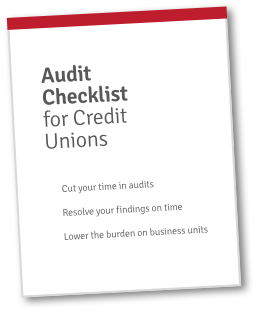Do you want to guarantee that your credit union deals with audit findings reliably and on time? In this blog, we outline simple, repeatable process to ensure that your findings are cleared quickly.
The final key to effective audits is communication. All the experience in the world won’t help if your audit team can’t communicate internally or externally.
Here’s what audit communication for credit unions should look like.
This is the third and final article in a series about resolving audit findings on time. Read about the role of structure in audits here, or read about working with business units here.
Examples of Poor Communication in Audits
Not all communication is good communication. Sometimes, what we think of as “good communication” is actually poor communication in disguise.
- Email is unreliable. It’s good for short-term communications, but it’s a bad “filing cabinet” for audit-related activities. If you need to find an answer from months or even years ago, email gets tough to work with and hinders productivity.
- Not reporting up. Audit teams must keep management, the supervisory committee, and other auditors/examiners current about progress and activity. It’s necessary, but it takes a lot of time, so it’s a common shortcut.
- Surprises. Some surprises are nice, but during audits, they’re generally unwelcome. When the unexpected pops up, it takes attention away from immediate tasks and throws everything off schedule.
Normally, one might expect any communication to be good. However, the time investment and lack of organization of these traditional methods makes things difficult.
How to Improve Audit Communication
We’ve identified five key aspects of effective audit communication:
- Clarity. It should always be clear what’s going on—who is doing what, and when?
- Transparency. All information should be accessible and easy to find (preferably in one place).
- Documentation. Document everything. Keep evidence of manager responses, remediations, etc.
- On time. Communications should be timely—late communication leads to late assignments.
- As expected. There should be no curveballs or surprises. (An audit checklist may help!)
There are several actions your audit committee can take to ensure these key aspects of audit communication. For example:
- Keep business units informed. Send out daily “due today” emails to everyone who has a deadline that day.
- Report up and out. Report up to management, your supervisory committee, and the board. Report out to external auditors, examiners, etc. At a minimum, report weekly.
- Create templates. They should be easy to fill out so that nobody starts at square one for any given report.
In the interest of space, we’ll end that list early. However, there are many more items to cover, including suggestions for documentation, storage and organization, and keeping business units on track.
Learn all that and how to manage (and resolve) findings on time without a spreadsheet in our next webinar:
Free Webinar
Final Thoughts About Communication
The old saying goes, “teamwork makes the dream work.” And a cornerstone of teamwork is communication. All parties must know what needs to be done, how, and by when. And if all these expectations are explicit and accessible, your audit team and business units will thank you.
But there’s more to it. Join us for our next Findings Accountability Framework webinar. We’ll cover this topic in detail, plus we’ll dig into the other critical components of a successful audit program.


 Get FREE Access to the Audit Checklist for Credit Unions!
Get FREE Access to the Audit Checklist for Credit Unions!


